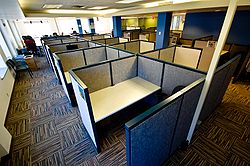

A cubicle is a partially enclosed office workspace that is separated from neighboring workspaces by partitions that are usually 5–6 feet (1.5–1.8 m) tall. Its purpose is to isolate office workers and managers from the sights and noises of an open workspace so that they may concentrate with fewer distractions. Cubicles are composed of modular elements such as walls, work surfaces, overhead bins, drawers, and shelving, which can be configured depending on the user's needs. Installation is generally performed by trained personnel, although some cubicles allow configuration changes to be performed by users without specific training.
Cubicles in the 2010s and 2020s are usually equipped with a computer, monitor, keyboard and mouse on the work surface. Cubicles typically have a desk phone. Since many offices use overhead fluorescent lights to illuminate the office, cubicles may or may not have lamps or other additional lighting. Other furniture often found in cubicles includes office chairs and filing cabinets.
The office cubicle was created by designer Robert Propst in Scottsdale, AZ for Herman Miller, and released in 1967 under the name "Action Office II". Although cubicles are often seen as being symbolic of work in a modern office setting due to their uniformity and blandness, they afford the employee a greater degree of privacy and personalization than in previous work environments, which often consisted of desks lined up in rows within an open room.[1][2] They do so at a lower cost than individual, private offices.[3] In some office cubicle workspaces, employees can decorate the walls of their cubicle with posters, pictures and other items.
A cubicle is also called a cubicle desk, office cubicle, cubicle workstation, or simply a cube. An office filled with cubicles is sometimes called a sea of cubicles, and additionally called pods (such as 4-pod or 8-pod of cubes)[4] or a cube farm. Although humorous, the phrase usually has negative connotations.[5]
Cube farms are found in multiple industries including technology, insurance, and government offices.
- ^ Cite error: The named reference
autogenerated2005was invoked but never defined (see the help page). - ^ Cite error: The named reference
autogenerated1998was invoked but never defined (see the help page). - ^ Diaz, Jesus (17 August 2018). "The real reason your company switched to an open plan office". Inc. Retrieved 17 August 2018.
- ^ Kirsner, Scott (1 August 2004). "Time (Zone) Travelers". Fast Company. Retrieved 4 May 2012.
- ^ Technology, Copyright © Massachusetts Institute of; reserved, 1977-2023 All rights (2020-11-25). "Enter the Cube Farm". MIT Sloan Management Review. Retrieved 2023-08-15.
{{cite web}}: CS1 maint: numeric names: authors list (link)